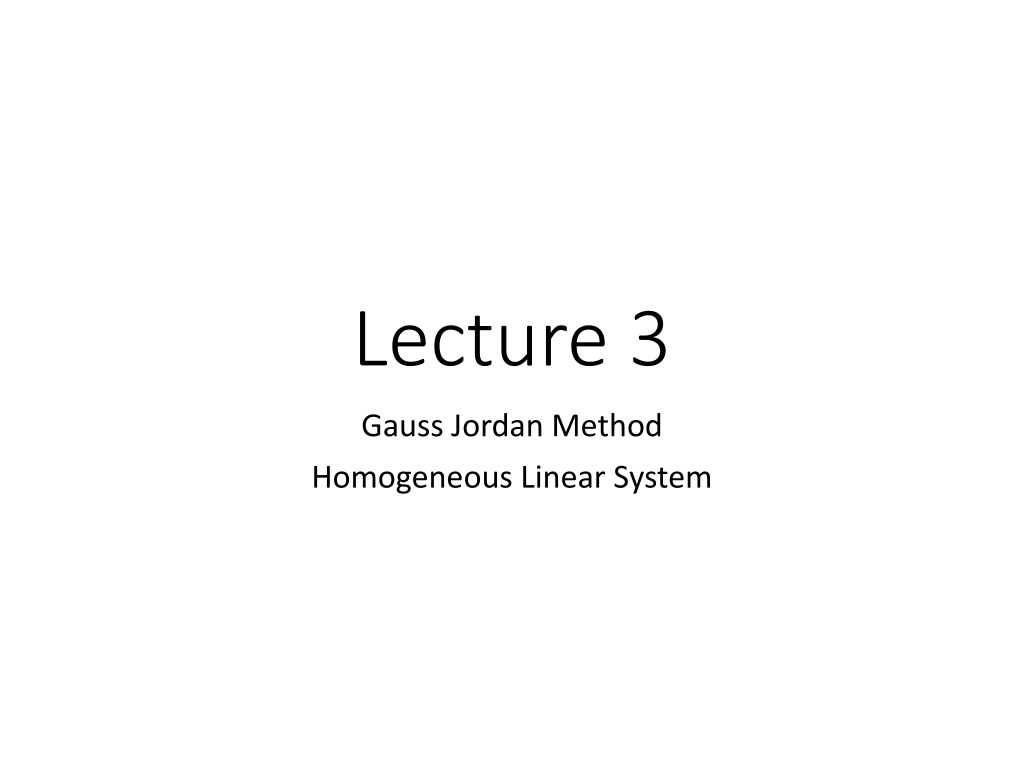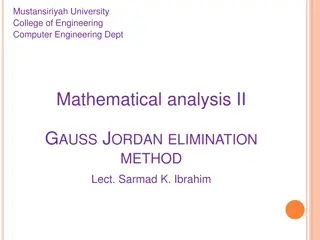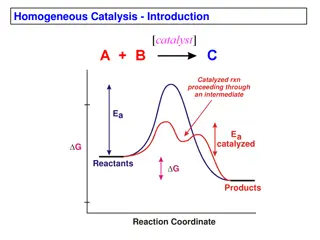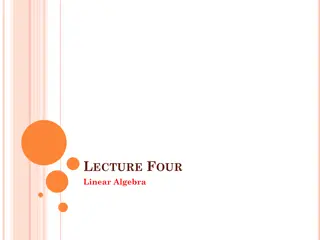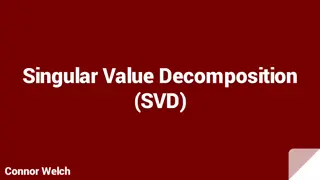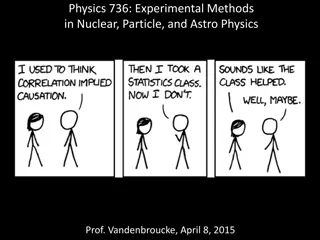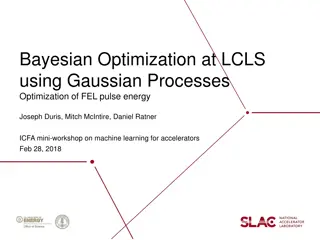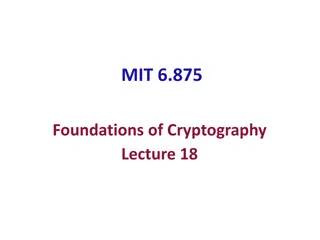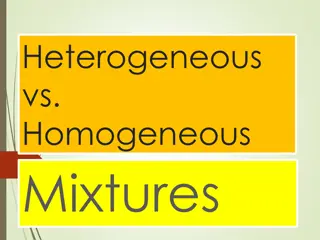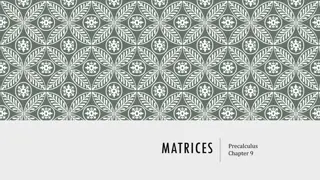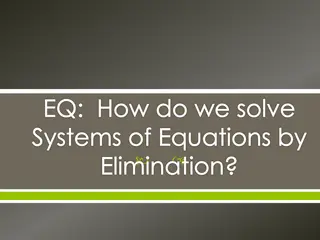Understanding Gaussian Elimination and Homogeneous Linear Systems
Gaussian Elimination is a powerful method used to solve systems of linear equations. It involves transforming augmented matrices through row operations to simplify and find solutions. Homogeneous linear systems have consistent solutions, including the trivial solution. This method is essential in linear algebra for solving complex equations efficiently.
Download Presentation

Please find below an Image/Link to download the presentation.
The content on the website is provided AS IS for your information and personal use only. It may not be sold, licensed, or shared on other websites without obtaining consent from the author. Download presentation by click this link. If you encounter any issues during the download, it is possible that the publisher has removed the file from their server.
E N D
Presentation Transcript
Lecture 3 Gauss Jordan Method Homogeneous Linear System
Example 4 Gauss-Jordan Elimination(1/4) Solve by Gauss-Jordan Elimination 2 3 3 2 1 + x + + = 2 x x 0 x x x 5 + = 2 6 5 2 4 3 1 x x x x x 1 2 3 4 5 6 + + = x x 5 10 + 15 = 5 x x 3 4 6 + + 18 2 6 8 4 6 x x x 1 2 4 5 6 Solution: The augmented matrix for the system is - 5 - 6 2 1 3 - 2 0 2 0 0 2 4 - 3 - 1 0 0 5 10 0 15 5 2 6 0 8 4 18 6 3
Example 4 Gauss-Jordan Elimination(2/4) Adding -2 times the 1st row to the 2nd and 4th rows gives 0 2 - 1 - 0 0 1 3 - 2 0 2 0 0 - 3 - 1 0 0 5 10 0 15 5 0 0 4 8 0 18 6 Multiplying the 2nd row by -1 and then adding -5 times the new 2nd row to the 3rd row and -4 times the new 2nd row to the 4th row gives 3 - 0 2 1 0 0 1 3 - 2 0 2 0 0 1 0 0 0 0 0 0 0 0 0 0 0 0 6 2 4
Example 4 Gauss-Jordan Elimination(3/4) Interchanging the 3rd and 4th rows and then multiplying the 3rd row of the resulting matrix by 1/6 gives the row-echelon form. 1 3 - 2 0 2 0 0 0 0 - 1 - 2 0 - 3 - 1 0 0 0 0 0 1 1 3 0 0 0 0 0 0 0 Adding -3 times the 3rd row to the 2nd row and then adding 2 times the 2nd row of the resulting matrix to the 1st row yields the reduced row- echelon form. 0 0 0 2 1 0 0 3 1 3 0 4 2 0 0 0 0 0 0 0 1 1 0 0 0 0 0 0 0 5
Example 4 Gauss-Jordan Elimination(4/4) The corresponding system of equations is x 2 4 3 + x + + + = 0 = x x x 1 2 4 5 2 0 x x 3 4 = 1 6 3 Solution The augmented matrix for the system is 3 = x = 4 2 x x x x 1 2 4 5 2 x x 3 4 = 1 6 3 We assign the free variables, and the general solution is given by the formulas: = = = = = = 3 4 2 , , 2 , , , x r s t x r x s x s x t x 1 1 2 3 4 5 6 3 6
Homogeneous Linear Systems(1/2) + + + = ... 0 a x a x a x A system of linear equations is said to be homogeneous if the constant terms are all zero; that is , the system has the form : 11 1 12 2 1 n n + + + = ... 0 a x a x a x 21 1 22 2 2 n n a x x + x + + = ... 0 a a 1 1 2 2 m m mn n Every homogeneous system of linear equation is consistent, since all such system have as a solution. This solution is called the trivial solution; if there are another solutions, they are called nontrivial solutions. There are only two possibilities for its solutions: The system has only the trivial solution. The system has infinitely many solutions in addition to the trivial solution. = = = , 0 ,..., 0 0 x x nx 1 2 8
Homogeneous Linear Systems(2/2) In a special case of a homogeneous linear system of two linear equations in two unknowns: (fig1.2.1) + = ( 0 , not b both zero) a x b y a b 1 1 1 1 + = ( 0 , not both zero) a x b y a 2 2 2 2 9
Example 7 Gauss-Jordan Elimination(1/3) + + = 2 2 0 = x x x x 1 2 3 5 Solve the following homogeneous system of linear equations by using Gauss- Jordan elimination. + + 2 3 0 x x x x x 1 2 3 4 5 + 2 0 = + x x x x 1 2 3 5 + 0 = x x x 3 4 5 Solution The augmented matrix 2 2 2 1 0 1 0 1 1 1 1 3 1 0 0 2 0 1 0 0 0 0 1 0 1 1 0 0 1 0 Reducing this matrix to reduced row-echelon form 0 0 1 0 1 0 0 0 0 1 0 0 0 0 0 0 0 0 10
Example 7 Gauss-Jordan Elimination(2/3) Solution (cont) The corresponding system of equation + + 0 = x x x 1 2 5 + 0 = x x x 3 5 0 = 4 = Solving for the leading variables is x x x 1 2 5 = x x 3 5 = 0 x 4 Thus the general solution is = = = = = t , , , , 0 x s x s x t x x t 1 2 3 4 5 Note: the trivial solution is obtained when s=t=0. 11
Theorem 1.2.1 A homogeneous system of linear equations with more unknowns than equations has infinitely many solutions. Note: theorem 1.2.1 applies only to homogeneous system Example 7 (3/3) 12
Homogeneous Linear Systems A system of linear equations is said to be homogeneous if the constant terms are all zero. + + + x a x a = 0 a x a x a x 11 1 12 2 1 n n + + + = 0 a x 21 1 22 2 2 n n a + x + x + a = n 1 0 a x 1 2 2 m m mn Every homogeneous sytem of linear equations is consistent, since all such systems have x1=0,x2=0,...,xn=0 as a solution [trivial solution]. Other solutions are called nontrivial solutions. Linear Algebra - Chapter 1 13
Homogeneous Linear Systems Example: [Gauss-Jordan Elimination] + + = 2 x 2 x 0 x x x x 1 + 2 3 5 + = 2 3 0 x x x 1 2 x 3 4 5 + = 2 0 x x x 1 2 x 3 5 + + = 0 x x 3 4 5 2 2 2 1 0 1 0 1 1 0 0 1 0 1 1 1 1 3 1 0 0 0 1 0 1 0 1 2 0 1 0 0 0 0 1 0 0 0 0 1 1 0 0 0 0 0 0 0 Linear Algebra - Chapter 1 14
Homogeneous Linear Systems The corresponding system of equations is 0 5 2 1 = + x + + = x x x = x x x 1 2 5 0 x x = x x 3 5 3 5 = 0 = 0 x 4 4 Solving for the leading variables yields = = = = = , , , , 0 x s t x s x t x x t 1 2 3 4 5 The general solution is the trivial solution is obtained when s=t=0 Linear Algebra - Chapter 1 15
Homogeneous Linear Systems Theorem: A homogeneous system of linear equations with more unknowns than equations has infinitely many solutions. Linear Algebra - Chapter 1 16
